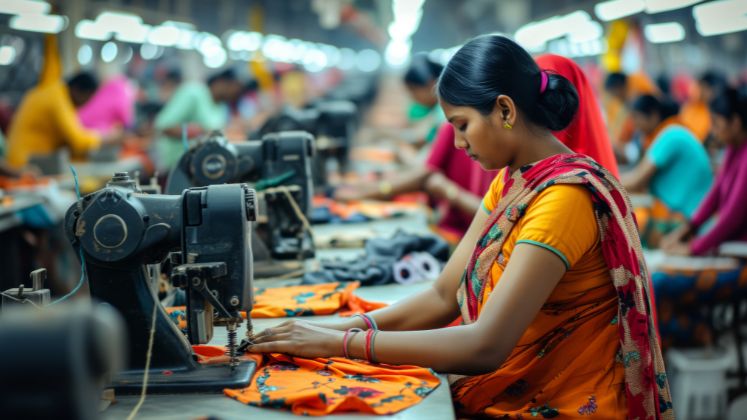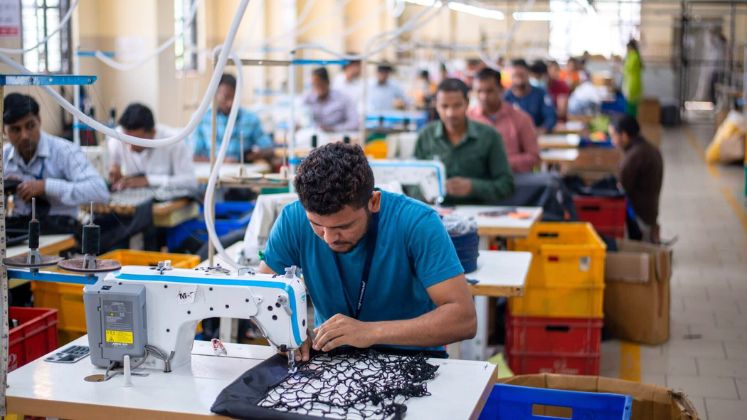
India is set to transition from the present minimum wage norm to a living wage system by 2025. To prepare for this change, the Government has requested consultations with the International Labour Organization (ILO) to build a framework. With over 500 million workers, of which 90 per cent are in the informal sector, the living wage initiative aims to uplift millions from poverty and safeguard their well-being. Although many workers earn a daily minimum wage of Rs.176 or more, the national wage standard has stayed the same since 2017. This has resulted in inconsistencies in wage payments across states due to lack of enforcement. As the apparel industry witnesses green shoots of recovery amidst a resurgence in overall consumption in 2024, the question arises: Is it prepared for the inevitable increase in costs associated with transitioning to the living wage system?
The International Labour Organization (ILO) defines living wage as “the wage level necessary to afford a decent standard of living for workers and their families, taking into account the country’s circumstances and calculated for the work performed during normal hours.”
On the other hand, the minimum wage is the lowest amount of payment mandated by law for work done within a specified period. While minimum wage aims to prevent underpayment, the living wage surpasses this by ensuring that income covers essential needs like food, clothing and shelter.
The factors considered in computing the living wage also differ from those for minimum wage. Living wage calculations take into account location, marital status and number of dependents, whereas the minimum wage is based on broader economic indicators.
India, a founding member of the ILO and a permanent fixture on its governing body since 1922, introduced the Code on Wages in 2019, aiming for a universal wage floor applicable to all states upon implementation. While strides towards a living wage are laudable, hurdles persist. Certain businesses, particularly small and medium enterprises, could encounter financial strain due to heightened labour expenses.
Even without transitioning to living wages, the continuous increase in production costs remains a concern. Retail prices have not kept pace with country-wide inflation over the years, making cost control a priority. While domestic market growth may help offset increased costs, manufacturers serving global markets must implement strategies to mitigate these increases.
While the industry supports wage increases, almost all the exporters we spoke to expressed concern about the erosion of India’s international competitiveness. According to Tapan Rajvanshi, CEO of Goldenseams Industries Pvt. Ltd. and former Executive VP for Arvind Limited, “The challenge arises when competing against countries like Bangladesh, which enjoy lower wages and additional benefits like duty-free access to the European Union.”
The Bengaluru-based Goldenseams is a manufacturer and exporter of readymade apparel for men, women and kids. With a workforce of 90 per cent women, the company serves clients worldwide, including multinational brands and retailers like Superdry, Michael Kors, Pepe Jeans and Jules, with a particular emphasis on bottomwear and shirts. With an annual turnover of US $ 35 million, Goldenseams produces 250,000 garments per month and supplies to over 30 international brands.
To soften the impact of living wage, Tapan and fellow exporters united to urge government assistance, proposing incentives such as waiving PF and other labour-related fees for industries. Additionally, they advocated for forging FTAs with countries like the UK or reducing customs duties to alleviate their concerns.

A major challenge in instituting a living wage system is the diverse living costs across India’s regions. Disparities in the cost of living between cities, states and even districts pose a formidable barrier to establishing a standardised living wage rate.
“While the Central Government will provide recommendations, it will be up to the State Governments to execute them. The key question is how much of these guidelines will actually be put into practice. Moreover, the rise in manufacturing costs will particularly affect states like Tamil Nadu, where minimum wages are slated for significant increases this year, even before the implementation of living wages in 2025,” commented Rakhi Handa, a freelance business consultant who formerly worked as Senior Managing Director, Product Safety and Quality Assurance at Target Sourcing Services and with brands like Levi Straus (India) Pvt. Ltd., Steve and Barry amongst others.
She warned that India is at a competitive disadvantage compared to Bangladesh because of variations in overheads and profit margin calculation between the two countries. Despite Bangladesh witnessing a considerable wage hike last year, the new minimum wages still fall below living wages and the escalated labour expenses are offset by the exchange rate of Taka to USD.
Companies shifting to hinterland
Moving manufacturing operations to the hinterland not only provides access to abundant labour pool but also serves as a strategic solution to mitigate the impact of upcoming living wage implementations. This is due to the cost savings resulting from reduced absenteeism, increased productivity and potential subsidies.
In cities, development has exacerbated the shortage of labour as individuals opt for higher-paying positions in malls as security guards or as household helpers. Despite efforts like offering higher-than-minimum wages, arranging transportation and providing other perks, there’s still a shortage of workers.
That’s why manufacturers are compelled to explore regions with abundant labour pools. Experts suggest that even if the workforce start off as unskilled, they can be trained in just a month or two. Moreover, there are government schemes such as Pradhan Mantri Kaushal Vikas Yojana to enable a large number of workers to take up industry-relevant skill training.
To facilitate this transition, states are offering attractive incentives to lure investors. For instance, recently, six leading apparel companies based in Noida and one from Bengaluru have committed substantial investments in Odisha’s apparel and garment cluster, Khurda. The total project cost stands at Rs. 379 crore, with the potential to create job opportunities for 18,620 individuals. In Odisha, the Employment Cost Subsidy entails that newly established industrial units are eligible to receive incentives. This includes Rs. 6000 per female worker per month and Rs.5000 per male worker per month for actual employment by the unit. This subsidy extends for a duration of five years (60 months) from the date of commencement of commercial production. However, it’s essential that payments made by the unit to its workers are Aadhar linked to fulfil the eligibility criteria.
Similarly, under the Employment Generation Subsidy, Bihar offers a subsidy equal to 300 per cent of the ESI and EPF contributions made by the unit as employment subsidy, subject to the following caps for different categories over a period of five years (up to Rs. 5000/month/employee). For semi-skilled workers, the subsidy is capped at Rs. 3000 per month, for skilled workers, it’s Rs. 4000, and for highly skilled workers, it’s Rs. 5000. To be eligible for this subsidy, units must ensure that at least 75 per cent of their direct employees are domiciled in Bihar, with a minimum of 100 such employees.

In Haryana, the government provides an employment generation subsidy of up to Rs.36,000 per year per employee for a period of 5 years or 20 per cent of the SGST deposited, whichever is lower, to all categories of textile enterprises. Additionally, it offers interest-free loans equivalent to the net SGST paid by the unit for a duration of seven years. Moreover, there is a freight assistance program providing support at 1 per cent of the FoB value or the actual freight cost, up to a maximum of Rs.20 lakh. Further assistance is available for textile machine manufacturing, including an interest subsidy of 3 per cent per annum and a capital subsidy of 15 per cent of the Gross FCI.
In Karnataka, the Textile and Garment Policy for MSMEs offers a range of incentives. For MSMEs, there’s a capital subsidy ranging from 15 per cent to 30 per cent of the value of fixed assets. Additionally, these enterprises benefit from an ESI/EPF incentive, with 75 per cent reimbursement of the employer’s contribution to the wage rate per employee per month for all new units over a 5-year period. Furthermore, SMEs receive a wage subsidy, where females are eligible for Rs. 1500 to Rs. 3000, while males can receive Rs. 1000 to Rs. 2000. For large enterprises, there’s a capital subsidy of 10 per cent to 25 per cent of the value of fixed assets. Moreover, these entities enjoy an interest subsidy of 5 per cent per annum on term loans for the initial five years. Similar to SMEs, large enterprises also benefit from wage subsidies, with females eligible for Rs. 1500 to Rs. 3000 and males for Rs. 1000 to Rs. 2000.
Whereas, the Gujarat government has recently introduced a new textile policy to boost the textile industry in the state. Under this policy, textile units are entitled to a significant 30 per cent capital subsidy, calculated based on their Gross Financial Capital Investment (GFCI). Moreover, textile units stand to gain from a 7 per cent interest subsidy on term loans for a decade from the initial disbursement. Additionally, the policy incorporates a power tariff subsidy of Rs. 2 per unit specifically for textile units, applicable for a duration of seven years.
Experts suggest that by taking advantage of these benefits, manufacturers can save up to 10 per cent -15 per cent of their total costs and remain unaffected by the implementation of living wages.
With the rapid infrastructure development across the country, logistic costs can also be minimised. In fact, having multiple manufacturing units enables seamless goods transfer nationwide. The current administration is prioritising infrastructure development like never before, evident in the allocated budgets: Rs. 2.78 lakh crore for the Road Ministry, a 2.8 per cent increase from last year; and Rs 2.55 lakh crore for the Indian Railways. According to CRISIL, India plans to invest nearly Rs. 143 lakh crore in infrastructure from 2024 to 2030, more than double the amount spent in the previous seven years. This will further aid businesses in their relocation efforts, helping them save costs and navigate the impact of living wage regulations.
“The commendable infrastructure development has enabled manufacturers to venture into new territories. However, infrastructure development doesn’t entirely solve the industry’s challenges. In the apparel industry, around 55 per cent of costs are incurred for raw materials, 15 per cent for labour and 30 per cent is related to infrastructure and miscellaneous expenditure. While infrastructure helps in logistics and transportation, it doesn’t directly address labour costs. To boost the industry, the focus should be on labour-friendly policies, wage subsidies and incentives to compete internationally,” noted Tapan Rajvanshi, one of the seven manufacturers establishing a new manufacturing base in Khurda.
Garment production hubs like Noida, Bengaluru, Gurgaon, Chennai and Tirupur are reaching a saturation point, argues Anil Peshawari, Director, Meenu Creation, a garment/home furnishing manufacturer based in Noida who will also open a new manufacturing base in Khurda. Meenu Creation operates five units with the capacity to produce 10 million garments annually. Its product range includes both woven and knitted garments as well as home furnishings such as bed, kitchen, table and bath linens. It serves clients such as KMart, Kiabi, Bikbok, Bonobo, Orsay, Cache, Camaieu, Cubus, Promod, El Corte Ingles, FG4, Jennifer, La Halle, Naf Naf, Phildar, Pimkie, Reserve, Sfera and Stradivarius.
“One of the primary reasons to set up a new unit in Khurda is that we started encountering labour shortages. Thus, we opted to relocate factories to areas where workers are available, rather than expecting workers to relocate to our established facilities. Everything, including various subsidies from the State Government, operates more cost-effectively there, resulting in enhanced production efficiencies.”
Experts said that having labour close to the factory can also significantly reduce absenteeism and enhance productivity. When workers live nearby, they face fewer transportation challenges and are more likely to arrive on time consistently. Also, proximity to home contributes to worker happiness and increased productivity, allowing them to spend quality time with their families and achieve a better work-life balance. Therefore, despite the increased expenses linked to living wages, which can already be offset by the solutions mentioned earlier, the output achieved remains significantly superior compared to urban settings, serving as an added bonus.
| “One of the primary reasons to set up a new unit in Khurda is that we started encountering labour shortages. Thus, we opted to relocate factories to areas where workers are available, rather than expecting workers to relocate to our established facilities.” Anil Peshawari Director Meenu Creation |
Offering his two cents, PR Balakumar, Managing Director of Rejoice Garments based in Tirupur, shared, “We frequently encounter labour shortages because workers from North India who come here temporarily for work often return after a few months. This has led to increased interest amongst factory owners in relocating closer to available labour pools.” Rejoice Garments, a manufacturer and exporter of garments for men, women and children, supplies to over 50 international brands and has a monthly capacity of 30,000 pieces.
He added that another way to circumvent living wage requirements and boost productivity is by sticking to a Piece-Rate system.
However, Rakhi Handa expresses concern that while relocating to the hinterland offers a clear labour cost advantage, the significant issue that needs to be addressed is the reluctance of experts such as engineers and managers to move to remote areas.
Meanwhile, Karan Sachdeva, MD, Prabhushree Dutt Textiles, a Delhi-based manufacturer and exporter of men’s socks has called for labour reforms. “In comparing India to China, it’s evident that China’s labour laws offer more advantages to manufacturers. For example, the cost of a button on a T-shirt is 10 paise in India, whereas in China, it’s 4 paise. This gap exists because workers in China operate 15 to 20 machines, while in India, regulations limit operators to handling only eight to ten machines.”
Focus on deskilling
All the solutions mentioned above are sure to give manufacturers more flexibility to absorb the impact of transitioning to the living wage system. Nonetheless, to further economise and cut costs, other options should be considered.
For example, many manufacturers currently experience significant waste in their factories, offering a significant chance to minimise costs. Rakhi advised, “Reevaluate the process from product design to raw material procurement, avoiding excessive ordering (+2 per cent and +5 per cent), which incurs significant costs; establish clear expectations with suppliers and optimise the quantities ordered. Direct attention towards consumables procurement, ranging from drinking water bottles to oil/diesel consumption, to minimise wastage and enhance cost-effectiveness. Implement more effective management strategies for preventive machine maintenance, spare parts procurement and replacement processes.”
Furthermore, attention should be on ‘deskilling’, which happens when technology reduces the need for skilled workers in an industry. For instance, a coffee machine replacing a skilled barista or a CNC machine replacing a machinist is an example of deskilling. Deskilling can also take place where complex skilled work undertaken by workers are broken down into simple unskilled tasks. Rather than an entire role being completely deskilled, technology can replace aspects of the work or help workers carry out the work efficiently.






